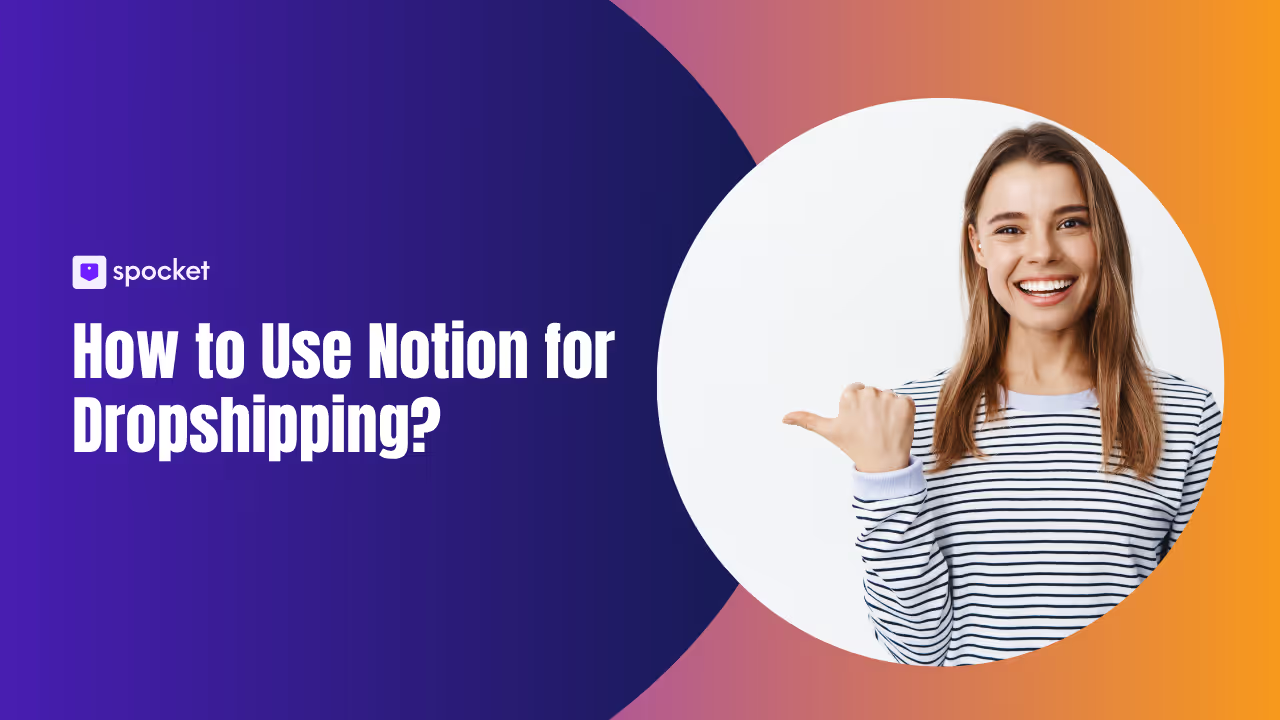Imagine launching an Amazon business without the hefty upfront investment typically required. This scenario isn't just a dream; it's a practical reality made possible through dropshipping. By leveraging Amazon's extensive platform, you can sell products directly from suppliers to your customers without ever handling the products yourself. This guide will walk you through how to start your dropshipping business on Amazon using strategic insights and effective tools like Spocket, aiming to minimize initial costs and streamline operations, allowing you to focus on growing your business from the ground up.
Before diving into the practical steps, let's first understand the dropshipping model and why it's particularly suited for selling on Amazon.
What is Dropshipping?
Dropshipping is a streamlined retail fulfillment method where you, the seller, do not keep products in stock. Instead, when a sale is made, you purchase the item from a third-party supplier, who then ships it directly to the customer. This business model is highly attractive for new entrepreneurs because it eliminates the need for significant upfront capital typically associated with buying and managing inventory. Dropshipping allows you to experiment with different market niches and products without financial risk, providing a flexible platform for testing and adapting your business strategy.
Understanding the benefits that Amazon offers can further highlight why dropshipping on this platform could be your key to e-commerce success.
Benefits of Dropshipping on Amazon
Amazon's platform offers distinct advantages that can amplify your dropshipping success. These include access to a massive customer base, the built-in trust that Amazon enjoys, and the scalability of operations without managing physical inventory.
With a grasp of these benefits, we're ready to set up your dropshipping venture step by step, beginning with selecting the right niche.
Vast Customer Base
Amazon's global marketplace is home to millions of active users. By listing your products on Amazon, you tap into an established audience base eager to purchase. This exposure can dramatically increase your potential sales volume without the need for extensive marketing campaigns.
Established Trust
Amazon is a trusted name in retail. Customers shopping on Amazon are more likely to purchase from a new seller on this platform due to the trust they have in Amazon's customer protection policies. This trust factor can lead to higher conversion rates compared to selling on lesser-known platforms.
Scalability
Dropshipping on Amazon allows you to scale your business operations without corresponding increases in overhead costs. You can list new products, test market demand, and discontinue underperforming products without dealing with unsold stock, which offers significant flexibility in managing your product catalog.
Step-by-Step Guide to Starting with Zero Investment
1. Choosing Your Niche and Product Research

The foundation of a successful dropshipping business lies in choosing the right niche. This should be a product category that not only interests you but also has a strong demand on Amazon. Utilize tools like Spocket to conduct comprehensive market research, identify trending products, and understand consumer demand patterns. Analyzing Amazon’s Best Sellers and using platforms like Google Trends or social media insights can help identify what products are capturing consumer interest.
Once you have a niche and products in mind, the next critical step is finding the right suppliers.
2. Finding and Partnering with Suppliers

One of the most critical steps in setting up a dropshipping business is finding reliable suppliers. Spocket, an established platform for finding dropshipping suppliers, offers a curated list of vendors whose product quality and delivery capabilities have been vetted. This reduces the risk of customer complaints related to product quality or shipping delays. Spocket also integrates seamlessly with Amazon, making the process of listing products and managing inventory more efficient.
After securing your suppliers, it's time to set up your storefront on Amazon.
3. Setting Up Your Amazon Seller Account

To sell on Amazon, you need to set up a seller account. You can choose between two plans:
- Individual Plan: Best for sellers who anticipate selling fewer than 40 items per month. There's no monthly fee; instead, you pay $0.99 per item sold.
- Professional Plan: Suitable for higher volume sellers, this plan costs $39.99 per month but eliminates the per-item fee, which can be more cost-effective as your sales increase.
Properly listing your products is pivotal to attracting and converting customers, so let’s focus next on optimizing your product listings.
4. Listing Products on Amazon

Your product listings are where customers make the decision to buy. Each listing should include high-quality images, detailed descriptions, and optimized titles packed with relevant keywords. Spocket’s automation tools can facilitate the listing process, helping you maintain accurate inventory levels and pricing, which is crucial for Amazon’s dynamic marketplace.
With your products listed, promoting them effectively is your next big challenge.
5. Marketing Your Products
Effective marketing is essential to distinguish your offerings on Amazon. Start by using Amazon’s Sponsored Product Ads to gain initial visibility. Complement this with organic social media marketing by creating engaging content that drives traffic to your Amazon listings. Utilize SEO techniques to optimize your product descriptions and titles, ensuring they are rich in keywords that potential customers are searching for. Collaborating with a full-service Amazon agency can help streamline these efforts, as they specialize in managing ads, optimizing listings, and handling customer interactions to boost your sales and reputation. Collaborating with a full-service Amazon agency can help streamline these efforts, as they specialize in managing ads, optimizing listings, and handling customer interactions to boost your sales and reputation.
As orders start to come in, efficient management of order fulfillment and customer service becomes essential to maintaining customer satisfaction.
6. Order Fulfillment and Managing Customer Service
Leverage Spocket’s fulfillment services to ensure that orders are processed and shipped quickly. Good fulfillment practices help maintain high customer satisfaction, which is critical for winning positive reviews and achieving good seller ratings on Amazon. Proactively manage customer service by quickly addressing customer inquiries and resolving any issues that arise, enhancing customer loyalty and trust.
Understanding the potential challenges and knowing how to navigate them can prepare you for a smoother operation.
7. Scaling Your Business
As you begin to see which products are performing well, consider expanding your offerings to include related items or exploring additional niches. Regular analysis of sales data and customer feedback will guide your decisions on which new products to introduce and which to discontinue. Transitioning to the Professional plan and investing more in marketing and product diversification are practical steps as your sales and business complexity grow.
With a clear understanding of how to establish and manage a dropshipping business on Amazon, it's equally important to weigh the pros and cons of this business model. Knowing these will help you navigate potential challenges more effectively and leverage the opportunities to your advantage.
The Pros and Cons of Amazon Dropshipping

Pros of Amazon Dropshipping
- Extensive Reach: Amazon offers instant access to millions of customers worldwide, eliminating the need for significant marketing efforts to establish a customer base.
- Reduced Capital Requirement: With no need to purchase or store inventory, you can start a business with limited financial resources and avoid the risks associated with unsold stock.
- Flexibility: Easily test and adjust your product offerings based on customer demand and market trends without financial repercussions from unsold goods.
Cons of Amazon Dropshipping
- Intense Competition: The low barrier to entry on Amazon means you're competing with many other sellers, some of whom might be offering the same or similar products at competitive prices.
- Limited Branding Opportunities: Selling on Amazon places restrictions on how much you can brand your business, making it harder to build customer loyalty and recognition.
- Dependence on Suppliers: Your business's success heavily relies on the reliability and performance of your suppliers. Issues with product quality or fulfillment can directly affect your business reputation and customer satisfaction.
Understanding these pros and cons will prepare you for the common hurdles in dropshipping on Amazon. Let’s dive deeper into specific challenges you might face and explore strategies to overcome them.
Challenges and How to Overcome Them
1. Inventory and Supplier Management
- Challenge: Managing inventory levels can be complex without direct control, leading to potential stock-outs or overselling.
- Solution: Use advanced dropshipping tools like Spocket, which provide real-time updates and seamless integration with your Amazon store. This ensures that your listings are always accurate and reflect current stock levels.
2. Quality Control
- Challenge: Ensuring consistent product quality can be difficult when you don’t handle the products personally.
- Solution: Establish strong relationships with trustworthy suppliers and conduct regular quality checks. If possible, order samples of each product you intend to sell to verify quality and packaging before listing them on Amazon.
3. Customer Service Excellence
- Challenge: Providing excellent customer service can be challenging when shipping times and order fulfillment are out of your direct control.
- Solution: Set clear expectations with customers regarding shipping times and maintain open lines of communication. Handle any issues swiftly and consider offering small compensations for delays or errors to maintain customer satisfaction.
Tips for Success in Amazon Dropshipping
Success in dropshipping involves staying flexible and continually adapting to changing market dynamics. To deepen your skills and grow with confidence, check out this guide to master Amazon dropshipping.
1. Optimize Your Product Listings
Focus on creating detailed and keyword-rich product titles and descriptions. High-quality images and videos can also help enhance the appeal of your listings. Use SEO strategies to improve your visibility on Amazon and attract more customers.
2. Build a Recognizable Brand
Even within Amazon's constraints, you can develop a recognizable brand by providing consistent product quality, excellent customer service, and using customized packaging where possible to enhance the customer unboxing experience.
3. Leverage Analytics
Utilize Amazon’s detailed analytics tools to monitor your sales performance, understand customer behavior, and adapt your strategies accordingly. Tracking metrics such as conversion rates and traffic can help you make data-driven decisions.
4. Stay Ahead of Market Trends
Regularly research and follow emerging trends within your niche. Being one of the first to market with new products can provide a competitive advantage and allow you to capture significant market share.
5. Automate Operations
Implement automation tools like Spocket to streamline operations such as order processing, inventory management, and pricing adjustments. Automation can help you scale your business efficiently by reducing manual tasks and freeing up time to focus on strategic growth.
Conclusion
Launching a dropshipping business on Amazon offers a promising opportunity with potential for significant returns, provided you navigate the inherent challenges effectively. By understanding the pros and cons, preparing for potential challenges with proactive strategies, and continuously optimizing your operations, you can build a successful dropshipping business on one of the world's largest e-commerce platforms.






































